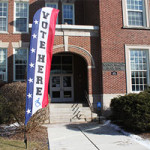
Believe it or not, a Government Accountability Office report issued after the 2008 election stated that in violation of state and federal laws, only 27% of polling places had no obstacles for disabled voters. Think this has a negative impact on voter turnout among disabled voters? You bet! According to Lisa Schur of Rutgers University’s School of Management and Labor Relations, the voter turnout rate in 2012’s presidential election was 5.7 percentage points lower than that of people without disabilities. This means if you’re an elections official overseeing the upcoming 2016 election, the time to start reviewing whether your polling place is accessible to disabled voters is now.
Polling place accessibility is about much more than access signs pointing to a wheelchair ramp. Indeed, many individuals with disabilities manage the wheelchair ramp into their polling place only to be confronted by a narrow door or an accessible voting machine that is missing parts. Beyond the party wins and losses, 2016 is an opportunity to improve your polling place usability. As preparations ensue, be sure to stay on the lookout for these five red flags, courtesy of the U.S. Department of Justice Civil Rights Division:
Parking: While many polling facilities provide parking to voters, the provision of accessible parking is a frequent oversight. Points to consider:
- Parking areas may either completely lack accessible parking or have an inadequate number of designated spaces.
- Parking may be without proper access aisles and signage.
- Parking may be located on a sloped surface.
- It is common for entrances other than the building’s main entrance to be identified as the polling place entry, particularly at large facilities such as schools. Permanent accessible parking may not be close to these points of entry.
Sidewalks and walkways: Even if the entranceways to your polling facility aren’t in a complete state of disrepair, know a voter using a wheelchair or other mobility device can easily be hindered by uneven, cracked, grass, and/or dirt surfaces. Furthermore, sidewalks may not include curb ramps, and curb ramps themselves may be too narrow or too steep to appropriately accommodate a wheelchair.
Entrances: Steps and narrow doors, particularly common in older facilities, can easily prevent a person with a disability from entering the polling place. Pay attention to whether the entrance to your facility is too narrow to allow for a wheelchair, has high door thresholds, or has a door that cannot be opened independently by someone with limited dexterity.
Hallways: Hallways in facilities such as schools and apartment buildings often house myriad hazards to the individual with a vision disability: drinking fountains, coat racks, and fire extinguishers, to name a few. Undetectable by the sweep of a cane, these objects create an unwanted opportunity for accident and injury.
Voting Areas: Check-in tables and voting booths need to have enough space for a wheelchair to easily maneuver. And remember that rain and/or snow isn’t exactly uncommon in November! Floor coverings such as cardboard and plastic tarps not only make it difficult for a voter in a wheelchair to navigate, but they present a risk for trips and falls.
While the above list may highlight some of the most common polling place violations under the ADA, it is far from comprehensive. Review the U.S. Department of Justice Civil Rights Division ADA Checklist for Polling Places.
Let’s work together to make 2016 the year of seamless voting experiences for all.
Learn more about Inclusion Solutions elections products and services.